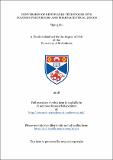Files in this item
Conversion of renewable feedstocks into polymer precursors and pharmaceutical drugs
Item metadata
| dc.contributor.advisor | Cole-Hamilton, D. J. (David John) | |
| dc.contributor.advisor | Kamer, Paul (Paul C. J.) | |
| dc.contributor.advisor | Smith, Andrew David | |
| dc.contributor.author | Shi, Yiping | |
| dc.coverage.spatial | xvi, 239 p. | en_US |
| dc.date.accessioned | 2018-11-14T16:32:16Z | |
| dc.date.available | 2018-11-14T16:32:16Z | |
| dc.date.issued | 2018-12-06 | |
| dc.identifier.uri | https://hdl.handle.net/10023/16461 | |
| dc.description.abstract | Fossils fuels are highly demanded in everyday life domestically or industrially. Fossil fuels are finite resources and they are rapidly depleting, as such alternative renewable feedstocks are sought to replace fossil fuels. Tall oil from paper processing and cashew nut shell liquid from the cashew nut industry are the two major renewable sources we studied, they are both waste byproducts, and have the potential to be converted into value-added materials. Tall oil from the paper industry mainly contained tall oil fatty acid, and under isomerising methoxycarbonylation with palladium catalyst, dimethyl 1,19-dimethyl nonadecanedioate can be obtained. This difunctional ester, dimethyl 1,19-dimethyl nonadecanedioate, is converted to diols, secondary and primary diamines by a hydrogenation reaction with ruthenium complexes of 1,1,1-tris(diphenylphosphinometyl)ethane (triphos) as catalysts in the presence of water, amine or aqueous ammonia respectively. In the case of aqueous ammonia it is necessary to use a two step reaction via diol to obtain 1,19-diaminononadecane. Diesters, diols and diamines are useful precursors for the synthesis of polyesters and polyamides. Difunctional substrates with 8-19 carbon chains are all tolerated under the reaction conditions and are successfully converted to the corresponding diols and diamines in high yields. Under similar hydrogenation conditions with the same ruthenium catalyst, cyclic products were predominantly produced with decreased chain length. N-heterocycles, which are important building blocks for the synthesis of drug molecules, were formed from the hydrogenation of diesters with 4-7 carbon chains in the presence of an amine. Another polymer precursor, ε-caprolactam, which is the precursor for Nylon 6, is obtained in a reasonable yield from both adipic acid and adipate esters together with aqueous ammonia in the presence of ruthenium catalyst. Cashew nut shell liquid was also converted into useful medical drugs, such as norfenefrine, rac-phenylephrine, etilefrine and fenoprofene in reasonable yields. Most of these drug molecules have been formed from 3-vinylphenol by catalytic hydroxyamination followed by methylation or ethylation. 3-Vinylphenol was synthesised from cardanol by ethenolysis to 3-non-8-enylphenol followed by isomerising ethenolysis, whilst the N-alkylation reactions used methyl or ethyl triflate to avoid dialkylation. Fenoprofene was formed by firstly O-phenylating cardanol then ethenolysis followed by isomerising ethenolysis to form 1-phenoxy-3-vinylbenzene. Methoxycarbonyation followed by hydrolysis formed the final product in good yield. Our methods start from renewable waste materials and avoid unpleasant reagents in the original stoichiometric synthesis of those drugs, for example, cyanide is no longer essential for the synthesis of fenoprofene. | en_US |
| dc.description.sponsorship | "The work was supported by the EPSRC for the critical mass grant 'Clean Catalysis for Sustainable Development' (EP/J018139/1); and Sasol Technology, UK (a case studentship Y. S.)." -- Acknowledgements | en |
| dc.language.iso | en | en_US |
| dc.publisher | University of St Andrews | |
| dc.subject | Green chemistry | en_US |
| dc.subject | Sustainable chemistry | en_US |
| dc.subject | Hydrogenation | en_US |
| dc.subject | Homogeneous catalysis | en_US |
| dc.subject | Renewable | en_US |
| dc.subject | Tall oil | en_US |
| dc.subject | Cashew nut shell liquid | en_US |
| dc.subject | Pharmaceutical drugs | en_US |
| dc.subject | Polymer precursors | en_US |
| dc.subject | N-heterocycles | en_US |
| dc.subject | Lactams | en_US |
| dc.subject | Diamines | en_US |
| dc.subject.lcc | TP155.2E58S5 | |
| dc.subject.lcsh | Green chemistry | en |
| dc.subject.lcsh | Hydrogenation | en |
| dc.title | Conversion of renewable feedstocks into polymer precursors and pharmaceutical drugs | en_US |
| dc.type | Thesis | en_US |
| dc.contributor.sponsor | Engineering and Physical Sciences Research Council (EPSRC) | en_US |
| dc.contributor.sponsor | Sasol Technology UK | en_US |
| dc.type.qualificationlevel | Doctoral | en_US |
| dc.type.qualificationname | PhD Doctor of Philosophy | en_US |
| dc.publisher.institution | The University of St Andrews | en_US |
This item appears in the following Collection(s)
Items in the St Andrews Research Repository are protected by copyright, with all rights reserved, unless otherwise indicated.

